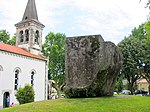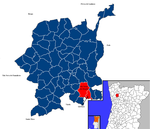Ara de Trajano

The Ara de Trajano is a Roman inscription made on a granite boulder located in Caldas das Taipas, Braga District, Portugal with an honorific inscription to Trajan, dated 103. It was classified as a Monumento Nacional(National Monument) by the Decreto of 16-06-1910, Diário do Governo, No. 136, of 23-06-1910.It is also known as Lápide das Taipas, Ara de Nerva or Penedo da Moura. The inscription is on one of the faces of a granite block cut into three faces, each of them approximately three meters high. The inscription reads:IMP(ERATOR) CAES(AR) NERVA/ TRAIANVS AVG(VSTVS), GER(MANICVS), DAC(ICVS)/ POT(IFEX) MAX(IMVS), TRIB(VNITIA) POT(ESTATE) VII/ IMP(ERATOR) IIII CO(N)S(UL) V, P(ATER) P(ATRIAE)] ("Emperor Cesar Nerva Trajan, Augustus, Germanicus, Doricus, Pontiff Maximus, with the tribune power for the seventh time, Emperor for the fourth time, Consul for the fifth time, Father of the Fatherland").
Excerpt from the Wikipedia article Ara de Trajano (License: CC BY-SA 3.0, Authors, Images).Ara de Trajano
Avenida da República, Guimarães
Geographical coordinates (GPS) Address Nearby Places Show on map
Geographical coordinates (GPS)
| Latitude | Longitude |
|---|---|
| N 41.48705 ° | E -8.344 ° |
Address
Avenida da República
4805-081 Guimarães (Caldelas)
Portugal
Open on Google Maps











